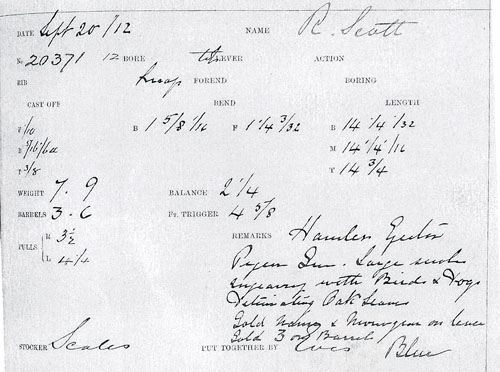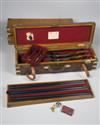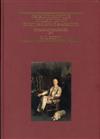Product Details
J. PURDEY & SONS
A MAGNIFICENT GARNITURE OF THREE 12-BORE SELF-OPENING SIDELOCK EJECTORS, serial no. 19246 / 7 and 20371
gun no. 1 and 2 (game guns):
29 1/2in. Whitworth-steel nitro chopperlump barrels, ribs gold-inlaid 'J. PURDEY & SONS, AUDLEY HOUSE, SOUTH AUDLEY STREET, LONDON.', and gold-inlaid '1' and '2', the bottom ribs engraved 'MADE OF SIR JOSEPH WHITWORTH'S FLUID PRESSED STEEL', 2 1/2in. chambers, bored approx. 1/4 and 1/2 choke;
gun no.3 (live pigeon gun):
30in. Whitworth-steel nitro chopperlump barrels, broad raised matt rib gold-inlaid 'J. PURDEY & SONS, AUDLEY HOUSE, SOUTH AUDLEY STREET, LONDON.', and gold-inlaid '3', the bottom rib engraved 'MADE OF SIR JOSEPH WHITWORTH'S FLUID PRESSED STEEL', 2 3/4in. chambers, bored approx. full choke in both;
side-clipped self-opening treble-grip actions with removable striker discs, fences deeply carved in relief with oak leaf and acorn motifs, gun no.3 with deeper standing breech, automatic safeties with gold-inlaid 'SAFE' details, toplevers gold-inlaid with the monogram 'RS', arrow cocking-indicators (gun no. 1 & 2) and blued cocking-indicators (gun no.3), the actions, lockplates and furniture profusely engraved with best fine acanthus scrollwork on a matt background, surrounding finely engraved vignettes of partridge and mallard in flight, the undersides with pointers in a woodland setting, the triggerguards with an English partridge, blacked finish overall with the makers name and serial numbers inlaid in gold, 14 1/2in. highly-figured stocks, gun no.3 including 1/2in. rubber recoil pad, weight 6lb. 13oz. (gun no.1 and 2) and 7lb. 12oz. (gun no.3), in their brass-mounted oak and leather two-tiered triple motor case with accessories; together with their individual brass-cornered oak and leather double case for guns 1 and 2 and brass-cornered oak and leather single case for gun no.3.
The makers have kindly confirmed that gun no. 1 and 2 were completed as a pair for a Mr R. Scott in 1909 and that gun no.3 was made to complement the pair in 1912, for the same client. The guns were passed on to Mr M. Scott in 1948. The engraving is likely to be the work of Harry Kell.
Provenance: Robert Lyons Scott was born near Greenock in 1871 into a wealthy Scottish shipbuilding family. At the time, his father, J.C. Scott, was Chairman and senior partner of the firm John Scott & Sons which was the oldest shipbuilding company in Britain having been established in 1711. He was schooled at Wellington College and after, intended to join the Royal Artillery as his elder brother was being groomed to take control of the family firm. However, the R.A. turned him down on account of his indifferent eyesight and so it was that he became a Director of Scott's and remained there for the rest of his life. The Royal Artillery's decision has a degree of irony as Scott was already an excellent game shot and was later to become a prominent big game hunter as well as captaining Scotland's fencing team.
Scott's elder brother died in 1915 and so the family shipbuilding mantle was placed entirely on his shoulders. This furthered his already considerable wealth by some margin and so it was, once the Great War had ended, that he was able to secure many items of historic importance that were being sold to help families who had lost their heirs and therefore their future. It should be noted that Scott was one of the few people nationally who could compete at financial level with the 'new money' in America. If it had not been for him then many items of national importance would have crossed the ocean.
Robert Scott was an innately modest man, shy and somewhat withdrawn by nature, who, by the time of his death, had amassed a collection of arms and armour of such importance that it rivalled those of William Wallace, the Fitzwilliam Museum and The Royal Armouries. He became an expert in his field and his collection was so complete and important, in part, because he knew and understood exactly what he was buying. In many cases the items he secured, especially armour, had been on his 'list' for years.
He was a very keen game shot and from this he developed an interest in big game hunting. He travelled the world on various safaris including six made to Africa where he employed the services of renowned P.H. Richard John Cuninghame, known usually as R.J. (see lot 1327 for associated provenance). Cuninghame's reputation went before him and Scott was determined that he should lead his first African safari. The two men became great friends and in 1919 Holland & Holland completed the pair of Royals that Scott had ordered as a gift for his friend, these being duly delivered to Cuninghame at the Caledonian Club.
The 1930s brought the depression and the Scottish shipyards suffered terribly as a result. Scott could see the Clyde from the family home 'Balclutha' and showed his philanthropic nature by electing not to take his Chairman's salary but instead to share it out amongst key members of his staff, thus ensuring the survival of the firm. However, his final and greatest act of philanthropy though was to follow his death.
Scott had spent much of 1938 confined to his house with an illness that ulimately was to claim him. A trip was made to South Africa to recuperate and, apparently feeling rather better, he returned home the following year to accept an appointment from the Prime Minister as a Trustee of the Wallace collection. However, he contracted a summer chill and died, seated in his favourite chair at home on 5th July. His bequest was that his collection, 'the most considerable…..in private hands at that time', be given to the city of Glasgow and her people. Even Sir William Burrell, the other well-known benefactor of Glasgow, and also a shipbuilder, (see lot 1523, March 2009 sale) was moved to say that the 'Scott bequest is the most significant thing of its kind to happen in Scotland since the foundation of this municipal collection'.
Estimate £80,000-100,000
THE ABOVE LOT WILL REQUIRE THE BUYER TO PRODUCE A RELEVANT BRITISH SHOTGUN CERTIFICATE OR REGISTERED FIREARMS DEALER LICENCE BEFORE IT MAY BE RELEASED.








